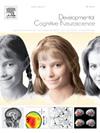绘制早期胼胝体发育图以识别神经发育风险
IF 4.9
2区 医学
Q1 NEUROSCIENCES
引用次数: 0
摘要
本研究利用性别特异性生长曲线模型研究了儿童早期胼胝体的发育,这是认知成熟的关键过程,与自闭症谱系障碍(ASD)有关。295名典型发育儿童(TDC, 1-6岁)的结构MRI数据用于模拟10个形态计量参数的年龄和性别依赖性变化,包括亚区体积和正中矢状面特征。分析揭示了雌性的非线性发育轨迹、特定区域的生长速率和更早的发育高峰。我们将这些规范模型应用于41名TDC和26名ASD儿童的独立数据集,这些数据集是通过不同的扫描仪获得的。根据生长曲线偏差训练的分类器可以准确区分ASD儿童和TDC儿童(平均受试者工作特征曲线下面积[AUC] = 0.95),证明了模型的可泛化性。这些发现建立了性别特异性胼胝体生长曲线模型,作为表征典型发育和检测非典型形态的定量、可推广的工具,为早期、客观的ASD诊断和可能的及时干预提供了有希望的方法。在更多样化的人群中进一步研究模型的普遍性是必要的。本文章由计算机程序翻译,如有差异,请以英文原文为准。
Mapping early corpus callosum development to identify neurodevelopmental risk
This study investigated early childhood corpus callosum development, a critical process for cognitive maturation and implicated in Autism Spectrum Disorder (ASD), using sex-specific growth curve models. Structural MRI data from 295 typically developing children (TDC; aged 1–6 years) were used to model age- and sex-dependent changes in ten morphometric parameters, including subregion volumes and midsagittal plane features. Analyses revealed nonlinear developmental trajectories, region-specific growth rates, and earlier developmental peaks in females. We applied these normative models to an independent dataset of 41 TDC and 26 children with ASD, acquired on a different scanner. Classifiers trained on deviations from the growth curves accurately distinguished children with ASD from TDC (mean Area Under the Receiver Operating Characteristic Curve [AUC] = 0.95), demonstrating model generalizability. These findings establish sex-specific corpus callosum growth curve models as a quantitative, generalizable tool for characterizing typical development and detecting atypical morphometry, offering a promising approach for early, objective ASD diagnosis and potentially facilitating timely intervention. Further study of model generalizability across more diverse populations is warranted.
求助全文
通过发布文献求助,成功后即可免费获取论文全文。
去求助
来源期刊

Developmental Cognitive Neuroscience
NEUROSCIENCES-
CiteScore
7.60
自引率
10.60%
发文量
124
审稿时长
6-12 weeks
期刊介绍:
The journal publishes theoretical and research papers on cognitive brain development, from infancy through childhood and adolescence and into adulthood. It covers neurocognitive development and neurocognitive processing in both typical and atypical development, including social and affective aspects. Appropriate methodologies for the journal include, but are not limited to, functional neuroimaging (fMRI and MEG), electrophysiology (EEG and ERP), NIRS and transcranial magnetic stimulation, as well as other basic neuroscience approaches using cellular and animal models that directly address cognitive brain development, patient studies, case studies, post-mortem studies and pharmacological studies.
 求助内容:
求助内容: 应助结果提醒方式:
应助结果提醒方式:


